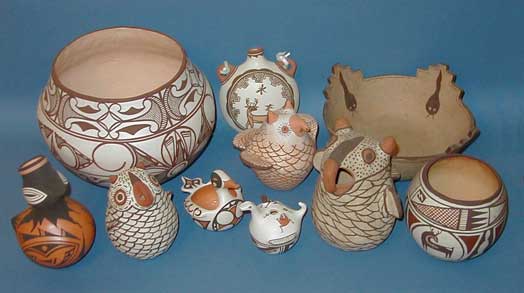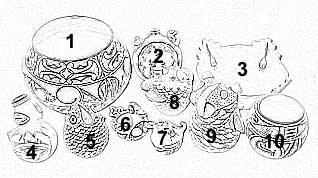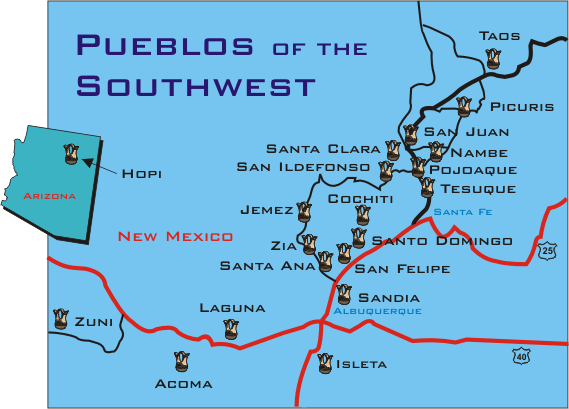 ClayHound Web
- Zuni Pueblo
ClayHound Web
- Zuni PuebloReturn to:
|
Zuni Pueblo Pottery |
|
|
|
|
|
|
|
|
Zuni Pueblo is located in west-central New Mexico. The early history of Zuni pottery is somewhat like that of Acoma and Laguna. All three villages traditionally use crushed pot sherds to temper the clay....in the beginning of the eighteenth century, Zuni Pueblo switched to mineral matte paint for decoration. The new matte-paint style is known as Ashiwi Polychrome (1700-1760)....at Zuni Pueblo there was a rare style of pottery, Zuni White-on-red, that perhaps survived as a holdover from Prehistoric days, in which the entire surface of the vessel was slipped a reddish color and decorated with motifs in white paint. Surviving examples seems to extend from about 1800 to perhaps as late as 1900. |
|
|
The Pueblo of Zuni is the largest of all the pueblos in New Mexico and was the first stop in the infamous search for the "Seven Cities of Cibola" by the Spanish in 1539. The following year, Coronado and his men had to fight to gain entrance into the pueblo which resulted in the death of 20 Zuni people. Although there is no gold to be found, there is an abundance of turquoise and silver jewelry. The Zuni people are famous for their "needlepoint" and "inlay" jewelry which can be found in shops locally and throughout the southwest. A must-see for visitors to the pueblo is the Our Lady of Guadaloupe Mission. Built in 1629, the mission has undergone several reconstruction phases. Today you will find 24 murals of kachinas painted on the interior walls of the church. The A:shiwi A:wan Museum and Heritage Center may be another stop for those individuals interested in learning more about the Zuni culture and people.
In the 1940s, pottery was a dying art among the Zunis.
It was revived by Hopi potter Daisy Hooee, daughter of Annie Healing
Nampeyo, and granddaughter of the famous Hopi potter, Nampeyo. In the
'20s, Daisy received a scholarship from a benefactor and studied
ceramics in Paris for two years. She returned to the States and
eventually married a Zuni, Sidney Hooee, and lived with her husband in
the Zuni Pueblo. |
|
|
She taught pottery making in the Zuni high school for a number of years in the 1960s and '70s. During this period, Daisy taught mostly older women, and taught traditional methods, as passed down from her grandmother and mother. She was followed by Jennie Laate, an Acoma woman married to a Zuni. It was Jennie who introduced the commercial kiln, and that is what is used by most Zuni potters, today.
from -
http://www.newmexico.org/culture/pueblo_zuni.html |
|



